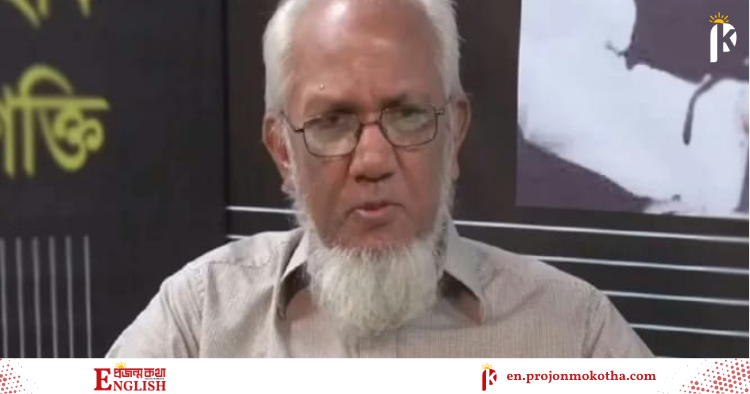Artificial Intelligence (AI) A Blessing or a Threat to Journalism

- Publish : 11:53:49 pm, Tuesday, 4 November 2025
- / 4
Photo: AI / Projonmo Kotha
With the rapid advancement of technology, the use of Artificial Intelligence (AI) is expanding across various sectors around the world- and journalism is no exception. Today, AI plays a significant role in news gathering, data analysis, headline generation, and even full news writing. However, this technology brings not only opportunities but also new challenges to journalism.
Major global news organizations have already begun integrating AI into their operations. Tools like the Associated Press’s Automated Insights, Reuters’s News Tracer, Forbes’s Bertie, and OpenAI’s ChatGPT help journalists analyze vast amounts of data in a short time. AI reduces the time required for repetitive tasks such as producing sports, business, and daily news stories while speeding up fact-checking processes. Chicago-based tech company Narrative Science predicts that by 2025, AI bots will be able to produce up to 90% of all news content. The software Quill can transform complex datasets into readable news reports. Prominent media houses like The Washington Post, BBC, Reuters, Bloomberg, and The New York Times are already using AI in their news production processes.
AI is not only being used to write news but also to personalize content for specific audiences, transcribe interviews, and generate photos, videos, and audio content. Combining multiple data sources, AI can now produce institutionally structured reports and tailor them to audience preferences. AI-driven algorithms track readers’ interests and deliver personalized news accordingly. For example, The Times’s JAMES program sends notifications based on readers’ reading habits, enhancing audience engagement and helping media outlets provide more relevant content.
AI-powered fact-checking tools are also proving to be effective in combating misinformation. Tools like AP Verify, Reuters Fact Check, Heliograf (The Washington Post), Factmata (Times of London), and fact-checking systems by The Guardian and The New York Times are helping prevent the spread of fake news.
 Writer— Shahria Nayan / Photo: Collected
Writer— Shahria Nayan / Photo: Collected
In Bangladesh, alongside traditional print media, numerous online news portals are now operating actively. In this competitive landscape, where the race is to deliver news faster than others, Artificial Intelligence can become the most effective tool. AI enables the rapid compilation of small bits of data into a complete news report within moments- complete with attractive headlines and structured content following journalistic standards.
However, the use of AI in journalism also poses several challenges. First, many journalists fear job displacement. According to the 2024 Media Metamorphosis: AI and Bangladeshi Newsrooms survey, there is growing concern among journalists about job security. A recent Pressat survey revealed that 2% of journalists have already lost their jobs due to AI automation, while around 57.2% fear widespread job losses in the future. They argue that as AI takes over routine tasks like news generation, headline creation, and fact-checking, the demand for human journalists is decreasing- especially for routine reporting.
Second, while AI can produce accurate reports if given correct instructions, it can also spread misinformation or biased content if guided incorrectly. Readers often cannot tell whether a report was written by AI or a human journalist. Moreover, when AI summarizes large reports, crucial details may be lost, potentially compromising the quality of news. AI can refine headlines but lacks the human creativity to introduce new perspectives.
Minhaj Aman, Research Lead at Activate Rights Information, Rights and Technology, noted that Prothom Alo has already started implementing AI in its newsroom. “Feature photos are being generated, videos are being created, and even text is being refined,” he said. However, he questioned whether AI could ever replace human curiosity and sensitivity in journalism, concluding, “It may not happen soon- but we can’t rule out the possibility entirely.” He also highlighted AI’s increasing role in data analysis and fact-checking through tools like NotebookLM, which can synthesize multiple news sources into clear summaries. Aman warned about algorithmic bias, saying, “AI models can be biased- and often are. Journalists should not rely on them blindly but use them as assistants.” He further suggested that journalists should investigate and report on AI bias itself.
Regarding regulations, Aman emphasized the need for clear AI policies to prevent misuse. “Policies must be crafted considering the country’s capacity and context,” he said.
Tahsin Ahmed, former Sub-editor at The Daily Ittefaq and Digital Content Assistant at Prothom Alo Bondhushava, stated, “Sometimes, I use ChatGPT to verify facts while preparing features. It can’t provide every detail, but it often cites credible sources. I also use AI-generated realistic images for stories. It saves a lot of time verifying information, which is a huge advantage.”
However, human creativity, investigative instincts, and ethical responsibilities cannot be replaced by machines. While AI may reduce the need for humans in repetitive reporting, it allows journalists to focus on more meaningful tasks. Yet, AI-generated reports could raise concerns about credibility, transparency, and objectivity. Problems like filter bubbles, echo chambers, and the rapid spread of false or harmful information might worsen. Privacy and data security issues could also emerge.
Bangladeshi media outlets are now embracing digital transformation by adopting a “Digital First” strategy, expanding digital sections, and recruiting skilled professionals. This transformation is evident in news sourcing, writing, presentation, distribution, and advertising.
If used as a supportive tool, AI can make newsrooms more dynamic, data-driven, and modern. But this requires clear ethical standards, transparency, accountability, journalist training, inclusion of AI and digital literacy in journalism education, and stronger skills in fact-checking and cybersecurity.
In conclusion, Artificial Intelligence presents both opportunities and challenges for journalism. When used responsibly- as a partner rather than a replacement- it can enrich the news industry and enhance journalistic quality. With proper use, AI can improve reporting standards, but it will never fully replace human journalists- it can only make their work smarter and more efficient.


















